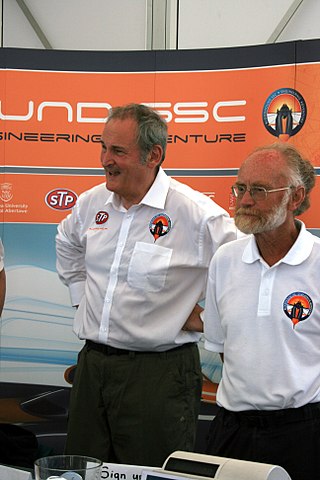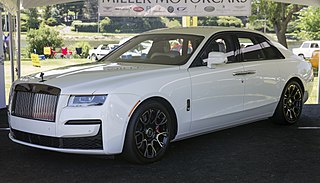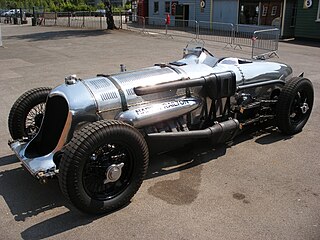
ThrustSSC, Thrust SSC or Thrust SuperSonic Car is a British jet car developed by Richard Noble, Glynne Bowsher, Ron Ayers, and Jeremy Bliss. Thrust SSC holds the world land speed record, set on 15 October 1997, and driven by Andy Green, when it achieved a speed of 1,228 km/h (763 mph) and it became the first and only land vehicle to officially break the sound barrier.

Spirit of America is the trademarked name used by Craig Breedlove for his land speed record-setting vehicles.

The Rover Company Limited was a British car manufacturing company that operated from its base in Solihull in Warwickshire. Its lasting reputation for quality and performance was such that its first postwar model reviewed by Road & Track in 1952 was pronounced finer than any but a Rolls-Royce. Rover also manufactured the Land Rover series from 1948 onwards, which spawned the Range Rover in 1970, and went on to become its most successful and profitable product — with Land Rover eventually becoming a separate company and brand in its own right.

Richard James Anthony Noble, OBE is a Scottish entrepreneur who was holder of the land speed record between 1983 and 1997. He was also the project director of ThrustSSC, the vehicle which holds the current land speed record, set at Black Rock Desert, Nevada in 1997.

The Rolls-Royce Spey is a low-bypass turbofan engine originally designed and manufactured by Rolls-Royce that has been in widespread service for over 40 years. A co-development version of the Spey between Rolls-Royce and Allison in the 1960s is the Allison TF41.

The Green Monster was the name of several vehicles built by Art Arfons and his half brother Walt Arfons. These ranged from dragsters to a turbojet-powered car which briefly held the land speed record three times during 1964 and 1965.

The Rolls-Royce RB.37 Derwent is a 1940s British centrifugal compressor turbojet engine, the second Rolls-Royce jet engine to enter production. It was an improved version of the Rolls-Royce Welland, which itself was a renamed version of Frank Whittle's Power Jets W.2B. Rolls-Royce inherited the Derwent design from Rover when they took over their jet engine development in 1943.

The world unlimited Water Speed Record is the officially recognised fastest speed achieved by a water-borne vehicle, irrespective of propulsion method. The current unlimited record is 511.11 km/h (317.59 mph), achieved by Australian Ken Warby in the Spirit of Australia in 1978.
The Wingfoot Express was Walt Arfons and Tom Green's jet-powered land speed record car, driven by Green to a record on October 2, 1964, after Walt suffered a heart attack just prior. The Express was powered by a Westinghouse J46 engine and hit the 413 mph record mark.

The Bentley S1 was a luxury car produced by Bentley Motors Limited from 1955 until 1959. The S1 was derived from Rolls-Royce's complete redesign of its standard production car after World War II, the Silver Cloud. Each was its maker's last standard production car with an independent chassis. The S-series Bentley was given the Rolls-Royce - Bentley L Series V8 engine in late 1959 and named the S2. Twin headlamps and a facelift to the front arrived in late 1962, resulting in the S3. In late 1965, the S3 was replaced by the new unitary construction Rolls-Royce Silver Shadow-derived T series.

The Rolls-Royce R is a British aero engine that was designed and built specifically for air racing purposes by Rolls-Royce Limited. Nineteen R engines were assembled in a limited production run between 1929 and 1931. Developed from the Rolls-Royce Buzzard, it was a 37-litre capacity, supercharged V-12 capable of producing just under 2,800 horsepower (2,090 kW), and weighed 1,640 pounds (770 kg). Intensive factory testing revealed mechanical failures which were remedied by redesigning the components, greatly improving reliability.
Rosco McGlashan OAM is an Australian drag racing record-holder, who currently holds the Australian land speed record at 500 mph (802.6 km/h). This record was set on the 27 March 1994 on the dry salt flats of Lake Gairdner, South Australia, 440 km (270 mi) northwest of Adelaide.
The Vampire is a jet-propelled car that currently holds the outright British land speed record, driven by Colin Fallows to a speed of 300.3 mph (483.3 km/h) on 5 July 2000 at Elvington, Yorkshire, England.
The British land speed record is the fastest land speed achieved by a vehicle in the United Kingdom, as opposed to one on water or in the air. It is standardised as the speed over a course of fixed length, averaged over two runs in opposite directions.

The North American Eagle Project was a jet powered car that was intended to challenge the 763 mph (1,228 km/h) land speed record set by the ThrustSSC in 1997. The venture was a collaboration between Canadian and US engineers, pilots, and mechanics. In 2013, they had hoped to reach 800 mph (1,287 km/h), or Mach 1.058.

The Rolls-Royce Ghost is a full-sized luxury car manufactured by Rolls-Royce Motor Cars. The "Ghost" nameplate, named in honour of the Silver Ghost, a car first produced in 1906, was announced in April 2009 at the Auto Shanghai show. The production model was officially unveiled at the 2009 Frankfurt Motor Show. The Ghost Extended Wheelbase was introduced in 2011. During development, the Ghost was known as the "RR04". It was designed as a smaller, "more measured, more realistic car" than the Phantom, aiming for a lower price category for Rolls-Royce models.

The Bluebird-Proteus CN7 is a gas turbine-powered vehicle that was driven by Donald Campbell and achieved the world land speed record on Lake Eyre in Australia on 17 July 1964. The vehicle set the FIA world record for the flying mile at 403.1 mph (648.7 km/h).
Bloodhound LSR, formerly Bloodhound SSC, is a British land vehicle designed to travel at supersonic speeds with the intention of setting a new world land speed record. The arrow-shaped car, under development since 2008, is powered by a jet engine and will be fitted with an additional rocket engine. The initial goal is to exceed the current speed record of 763 mph (1,228 km/h), with the vehicle believed to be able to achieve up to 1,000 miles per hour (1,609 km/h).
Thrust1 was a British-designed and built jet-propelled car. The car was designed and built by its driver Richard Noble, who later achieved the land speed record with his car Thrust2.

An aero-engined car is an automobile powered by an engine designed for aircraft use. Most such cars have been built for racing, and many have attempted to set world land speed records. While the practice of fitting cars with aircraft engines predates World War I by a few years, it was most popular in the interwar period between the world wars when military-surplus aircraft engines were readily available and used to power numerous high-performance racing cars. Initially powered by piston aircraft engines, a number of post-World War II aero-engined cars have been powered by aviation turbine and jet engines instead. Piston-engined, turbine-engined, and jet-engined cars have all set world land speed records. There have also been some non-racing automotive applications for aircraft engines, including production vehicles such as the Tucker 48 and prototypes such as the Chrysler Turbine Car, Fiat Turbina, and General Motors Firebirds. In the late 20th century and into the 21st century, there has also been a revival of interest in piston-powered aero-engined racing cars.















